Abstract
Ramírez-Zierold JA, Merino-Ibarra M, Monroy-Ríos E, Olson M, Castillo FS, Gallegos ME, Vilaclara G. 2010. 2010. Changing water, phosphorus and nitrogen budgets for Valle de Bravo reservoir, water supply for Mexico City Metropolitan Area. Lake Reserv. Manage. 26:23-34.
Valle de Bravo reservoir (VB) provides water supply to the Mexico City Metropolitan Area and other surrounding cities. Nutrient loading to this reservoir increased 276% for phosphorus (P) and 203% for nitrogen (N) in a single decade. During 2002–2005, P and N mean loadings to VB were 120.8 × 103 kg P/y and 591.8 × 103 kg N/y. These loadings were quite variable because of source variations from uncontrolled domestic and agricultural inputs. More than half (56%) of the maximal water storage of the reservoir was withdrawn annually. Water withdrawal removed 22% of the P input. Comparative examination of P and N mass balances showed that most (85%) of the P input to VB accumulates in the sediments. Despite the hypolimnetic anoxia that VB exhibits from March to October, net P accumulation in the sediments is normally observed. Our results confirm that although VB behaves as a warm monomictic water body, its mean hypolimnetic temperature increases throughout the stratification period. Nitrogen limitation was indicated by the dissolved inorganic nitrogen (DIN) to total dissolved P (DIN:TDP = 8.3, molar) ratio during stratification periods. We estimated that N2 fixation exceeded denitrification. This net fixation could double the N loading from rivers and sewage. Management recommendations include (a) gauging of river and sewage inputs to VB, (b) reduction of P input through treatment of sewage from VB town and (c) monitoring and regulating fertilizers and other nonpoint source inputs in the Amanalco watershed. Valle de Bravo reservoir is similar to other eutrophic tropical lakes and reservoirs that could also improve their water quality through these management practices.
In the last three decades there has been great concern about the increased eutrophication of aquatic systems worldwide from excess nitrogen (N) and phosphorus (P) loading (CitationLewis 2000, CitationConley et al. 2009). Human activity is accelerating rapidly in tropical watersheds, where eutrophication is becoming the main water quality issue (CitationDowning et al. 1999), interfering with the designated uses of these water bodies (CitationSalas and Martino 1991). In Mexico, a nationwide survey found that 68% of surface waters were contaminated, and 18% were already heavily contaminated by 1996 (CitationINEGI 1996).
Water quality problems can complicate the allocation of limited water resources in Central and Northern Mexico caused by uneven distribution of precipitation and population (CitationCNA 2008). Mexico City Metropolitan Area (MCMA) alone has over 20 million inhabitants and requires a large (66 m3/s) water supply (CitationTortajada 2006). Over 12% of this supply is provided by the Valle de Bravo reservoir (VB), the largest single surface source of water for the political and economic heart of the country.
Human activities in the watershed, including sewage disposal, have affected the water quality of the reservoir since the late 1980s (CitationOlvera-Viascán et al. 1998). Recent assessments report eutrophic conditions and cyanobacteria blooms (CitationMerino-Ibarra et al. 2008). Management of the watershed and sewage disposal is urgently needed to make VB a sustainable water source, but nutrient sources, sinks, overall loading and internal cycling remain largely unknown. There is a need to analyze and quantify these properties so that adequate management actions are taken.
External and internal nutrient loads are major concerns for water quality management in reservoirs. The importance of P sediment release has been outlined (CitationJensen et al. 1992), particularly in lakes with anoxic hypolimnia (CitationNürnberg 1984). However, other studies have found that P release depends more on P sedimentation and retention capacity of the sediments than on oxygen (CitationGächter and Wehrli 1998, CitationPrairie et al. 2002). There is less information on N budgets for lakes because of the numerous biological processes involved (e.g., denitrification, N2 fixation, nitrification). Fixation of N2 can account for 6–82% of the N input to eutrophic systems (CitationHowarth et al. 1988). Recent evidence suggests that N is largely denitrified rather than stored in the sediments of tropical lakes (CitationLewis 2002). Better understanding of how sedimentation and N2 fixation affect local storage of N (i.e., N retention) in tropical eutrophic systems is needed.
The combination of P and N loadings in lake enrichment models has proven very useful (e.g., CitationBachmann 1984). CitationSmith et al. (1989) have shown that comparative examination of water and several elemental budgets, in particular those of P and N, can yield insight into sources and sinks and the role of these fluxes in controlling nutrient availability. Nutrient budgets are key for management of highly eutrophic reservoirs (CitationHart et al. 2002). Here we examine the water and P and N budgets for VB. Our aim is to assess the nutrient loading, its variation and the net internal processes within the reservoir. We expect this will provide (1) an objective basis for sound management of this water source for the MCMA and for other reservoirs and lakes with similar behavior and (2) insight into some important questions and controversial aspects of nutrient cycling in eutrophic water bodies.
Study area
Local aquifers provide half of the MCMA water supply, but ever-increasing groundwater withdrawals are increasing land subsidence rates (CitationTortajada 2006), which are costly for the city. The rest of the supply is brought from outside the Mexico City basin, mainly from the Cutzamala System (CS), which comprises 7 interconnected reservoirs (). Water is pumped 1100 m upward along a distance of 127 km to reach Mexico City.
Figure 1 The Cutzamala System. Outline and distribution of the reservoirs (top). Altitude profile (bottom).
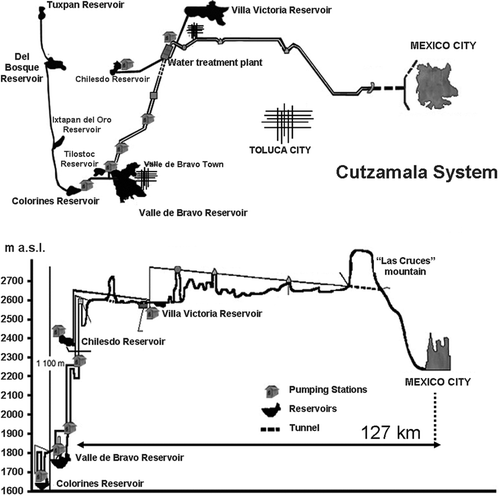
Valle de Bravo is the main reservoir of the CS, providing over one-third of the CS water supply to Mexico City. It is a tropical (19°21′ 30′ N, 100°11′00″W), high altitude (1830 m a.s.l.) reservoir (). Surface area of VB is 18.55 km2; maximum length 6.9 km; mean depth 21.1 m and maximum 38.6 m. Maximum storage capacity was calculated as 391 × 106 m3 in 2001 (CitationMerino-Ibarra et al. 2008). The climate in this region is warm to temperate with pronounced dry (Nov–May) and wet seasons (Jun–Oct). Mean precipitation is 836 mm/y and mean evaporation 1620 mm/y. Valle de Bravo receives water from a 546.9 km2 forested watershed (Olvera-Viascán et al. 1989) through the Amanalco River, smaller tributaries (Molino, González, Carrizal) and sewage outlets from the VB town, including the former Tizates River. Water from the western reservoirs of the CS is sometimes pumped into VB. Water withdrawal and pump-back occur at 20–28 m depths through a tower near the dam. Because the dam has a spillway, spillage can occur when the reservoir is over its capacity (at 1830 m a.s.l.). Baserocks are volcanic (basalts) and metamorphic, and no seepage from the reservoir has been identified (Olvera-Viascán et al. 1989).
Like other water bodies of the Mexican tropical highlands, VB behaves as a warm monomictic water body (CitationOlvera-Viascán et al. 1998). The reservoir is stratified from April to October and well-mixed from November to February. However, in 2001, CitationMerino-Ibarra et al. (2008) found a steady increase of hypolimnetic temperature during stratification, which they attributed to vertical mixing driven by the strong diurnal breeze (mean speed 7.4 m/sec) that blows daily (12–19 h) along the 2 main valleys of VB.
Valle de Bravo is an important tourist site in Central Mexico because of its natural beauty, due to its setting in a forested valley, mild climate and ideal conditions for water sports, particularly sailing. However, water quality in VB is affected by eutrophication. Olvera-Viascán et al. (1989) summarized data from VB and concluded that between 1980 and 1987 the reservoir became mesotrophic and would become eutrophic by 1993. In 2001, cyanobacteria dominated during the stratification period, the hypolimnion was completely anoxic and the reservoir remained under-saturated (< 60%), even during circulation (CitationMerino-Ibarra et al. 2008). Eutrophication in VB is a result of local town sewage, agriculture and wastewater discharges from the watershed. In 1987, CitationOlvera (1990) estimated that local sewage contributed 34% (16.0 × 103 kg P/y) and Amanalco River about 57% of the total P load to the reservoir. CitationOlvera-Viascán et al. (1998) studied the Amanalco River watershed in detail and calculated that nutrient loads to the reservoir through this river were 24.1 × 103 kg P/y and 168.5 × 103 kg N/y in 1992–1993.
Methods
The reservoir, rivers and sewage outlets were monitored every 28 days from January 2002 to August 2005. Seventeen stations in the reservoir were sampled (). Temperature, dissolved oxygen (DO) and oxidation-reduction potential (ORP) were measured at 1-m vertical intervals using a Hydrolab DS4/SVR4 field probe. Before each sampling, the oxygen sensor was calibrated using water saturated air and atmospheric pressure. The ORP sensor was calibrated using 2 quinone/hidroxyquinone solutions (at pH = 4 and pH = 7) as suggested by the manufacturer of the instrument. Water was collected with a 1.5-L Uwitec sampler at 0, 1, 2, 4, 8, 12, 16, 20, 24, 28 and 32 m depths when bottom depth allowed.
Figure 2 Bathymetric map of the Valle de Bravo reservoir (after CitationMerino-Ibarra et al. 2008) and location of the sampling stations, main inputs (rivers and sewages) and withdrawal point. Depth contours in m below the maximum level of the reservoir.
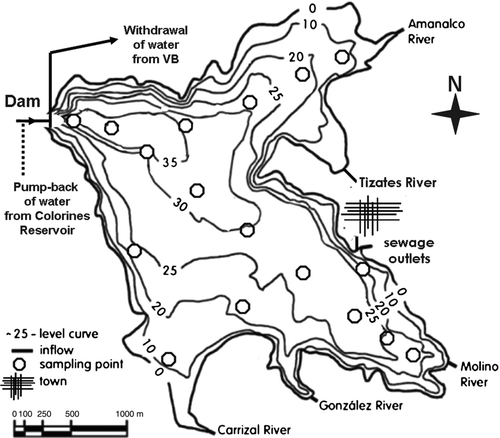
Rivers and sewage outlets were sampled within 500 m from the reservoir. Because tributaries to VB are not gauged, we also measured cross-section and water velocity (using a drift buoy) to determine water flow during each sampling. Mean current velocity was estimated using the Manning roughness empirical coefficient for wide and fully rough channels, a logarithmic vertical velocity distribution and a parabolic cross-sectional shape, a satisfactory approximation when 0 < 4× width/depth < 1 (CitationMartin and McCutcheon 1999), which was the case for all the sampled rivers.
Samples for nutrient analysis (NH4 +, NO2 −, NO3 − and soluble reactive phosphorus [SRP]) were filtered with 0.45 and 0.22 μ m (MilliporeTM type HA) nitrocellulose membrane filters and fixed with chloroform. Analyses were conducted with a Skalar SanPlus segmented-flow analyzer using standard methods adapted by CitationGrasshoff et al. (1983) and analytical circuits suggested by CitationKirkwood (1994). Samples for total dissolved nitrogen (TDN) and phosphorus (TDP) were filtered with 0.6–0.8 μ m (Whatman™ type GFF) fiber glass filters and kept at 4 C until analyzed. Particulate organic N (PON) and P (POP) were analyzed from these filters following CitationPujo-Pay and Rainbault (1994). The TDN, TDP, PON, POP, total N (TN) and P (TP) were analyzed as NO3 − and SRP after high-temperature persulfate oxidation (CitationValderrama 1981). Dissolved organic N (DON) and P (DOP) were calculated by subtraction. Data for N and P collected before June 2002 were lost, but other measurements are available and used in this study. To calculate the N:P ratio and assess nutrient limitation we used TDP because it better estimates bioavailable P in eutrophic freshwater systems (CitationBradford and Peters 1987).
Calculations
Previous detailed spatial studies in VB (CitationMerino-Ibarra et al. 2008, CitationNandini et al. 2008) have shown it is horizontally homogeneous; therefore, the reservoir was treated as a single box.
The water budget was calculated using:
These data were integrated between sampling dates to match sampling resolution of river inflows. The sum of measured river and sewage flows was compared () with the ∑ R i needed to close the water budget to assess the coherence between these measurements.
Table 1 Mean annual water budget for Valle de Bravo reservoir during 2002–2005.
Mass balances for P and N were calculated using:
The remaining term (NIP, the net element flux due to overall internal processes) was derived from equation Equation2. In interpreting NIP(P,N), the processes considered were net sedimentation (for both P and N) and net N2 fixation-denitrification. We fully attributed NIP(P) to net sedimentation. Nitrogen sedimentation was calculated from P sedimentation scaled by the particle N:P ratio and subtracted from the NIP(N) to obtain the net N2 fixation-denitrification.
Results and discussion
Thermal regime, DO, ORP and stratification
Temperature and DO distributions () confirmed that VB behaves as a warm monomictic lake, as observed in 1992–1993 (CitationOlvera-Viascán et al. 1998) and 2001 (CitationMerino-Ibarra et al. 2008). The reservoir exhibited similar seasonal patterns during the 4 years studied. Maximum surface temperature was reached in June, with slight variations (23.0–23.5 C) among years. Circulation began during October, and the water column remained homogeneous from December through January. Annual minimum water temperatures varied (17.5–18.5 C) between years, depending on winter cooling. Steady hypolimnetic temperature increases (2–3 C; ) were observed during the stratification period, as found in 2001 (CitationMerino-Ibarra et al. 2008).
Figure 3 Time-depth distributions of (a) temperature (C); (b) Dissolved oxygen (mg/L); (c) Oxidation-Reduction Potential (mV) at VB. The average of all sampled stations is shown. Sampling dates indicated by ticks at the top. Dark shape indicates the bottom of the reservoir at the deepest station.
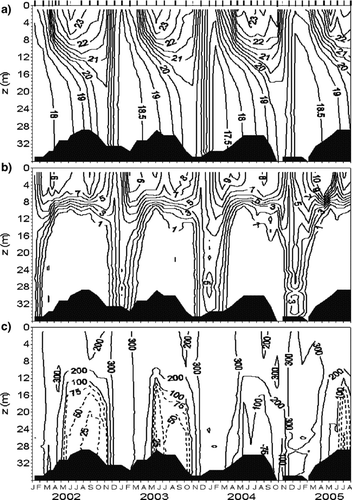
The hypolimnion of VB rapidly became anoxic at the onset of stratification. The duration of the anoxia varied ∼ 1 mo (Mar–Nov 2002 and Apr–Nov 2003 and 2004). These differences can also be traced by ORP within the anoxic periods. As expected under anoxic conditions, hypolimnetic ORP was below 200 mV () but reached its minimum in 2002 (−7 mV in Sep). In contrast, during 2004 hypolimnetic ORP decreased slightly (> 75 mV).
Water budget
During 2002–2005, the reservoir contained an average of 347.9 × 106 m3 of water, 89% of its maximum capacity (). Water volume varied seasonally () and decreased slightly (3%) during this period. However, water volume in VB declined substantially (18–44%) in the years subsequent to this budget (Valdespino-Castillo et al. in review). In 2002–2005, local evaporation (8% of maximum reservoir volume) exceeded local precipitation (4% of maximum reservoir volume), and water withdrawal (−220.8 × 106 m3/y) dominated the output portion of the budget, accounting for 56% of the system storage capacity. Therefore, the detention (or residence) time of water in VB during 2002–2005 can be estimated at 1.58 y. Pump-back to VB (9.7 × 106 m3/y) from the western reservoirs of the CS contributed only 2% of its capacity. Overall, to balance this water budget, a mean annual water input of 238.6 × 106 m3/y from rivers and sewage is needed. It is essential to gauge the rivers for the management of water supply of VB.
Figure 4 Temporal variation of (a) water, (b) phosphorus and (c) nitrogen fractions in the water column of VB. The dashed line on (a) indicates the maximum storage.
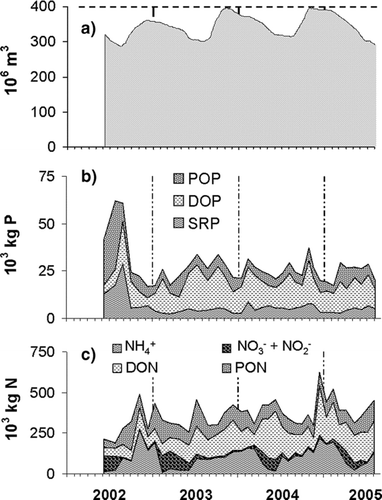
Measured river and sewage water flows (233.1 × 106 m3/y) matched predicted inputs closely. The residual differences were 2.7% of the predicted inputs and 1.6% of the reservoir volume (), suggesting that measured flows can be used to develop accurate nutrient load estimates. These residuals also enclose the combined amounts of flows not included in the budget, such as seepage. In the future, a budget of a nonreactive tracer, such as chloride, could be used to verify the exact magnitude of seepage in VB.
Amanalco River contributed 50% (117.3 × 106 m3/y) of the water inflow to VB in 2002–2005, a figure similar to that (123.0 × 106 m3/y) measured by CitationOlvera-Viascán et al. (1998) during 1992–1993. Molino River contributed almost one-third, while the sewage outlets measured accounted for 4% (10.2 × 106 m3/y) of the total water inflow. Rivers exhibited important flow variation () coupled to the strong seasonality between dry (Nov–Apr) and rainy (Jun–Oct) seasons. Pump-back took place mainly during September and was a minor contribution to total inflow (1–4%, depending on the year).
Figure 5 Temporal variation of inputs to VB of (a) water, (b) phosphorus and (c) nitrogen, and withdrawal of (d) water, (e) phosphorus and (f) nitrogen from the reservoir.
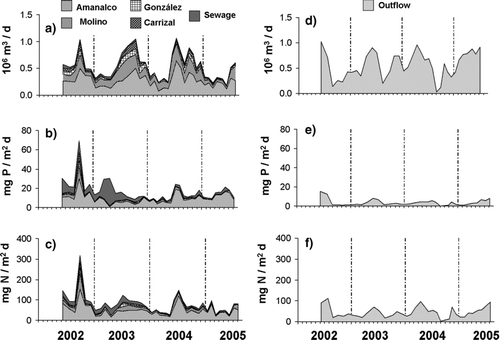
Water withdrawal from VB was irregular through time (), mostly due to water management differences between years. However, there was a trend of higher withdrawal during the dry season and the first months of the rainy season. Maximum rates (∼ 1 × 106 m3/y) occurred mainly during June and July. Spillage may have occurred during November and December of 2003 and 2004 when the reservoir reached its capacity (); however, our monthly water balance residuals enclose the possible spillage at these periods to within 0.5–1.2% of the reservoir's capacity.
External inputs of P and N
External nutrient loads to VB during 2002–2005 averaged 120.8 × 103 kg P/y and 591.8 × 103 kg N/y (). These loads are nearly 4 times the P mass and 1/2 the nitrogen mass contained in the reservoir. Amanalco River contributed more than half of this load (66.5 × 103 kg P/y and 342.2 × 103 kg N/y). Comparison with the loads assessed by CitationOlvera-Viascán et al. (1998) for this river from 1992–1993 shows that, in only a decade, nutrient load to VB through this river alone has increased 276% for P and 203% for N. Local sewage contributes 29% (35.2 × 103 kg P/y) of the total load of P to VB (). There was also a substantial increase (258%) of the sewage P load to the reservoir relative to that calculated by CitationOlvera (1990) in 1987. The estimated atmospheric deposition accounts to only 0.3 and 2% of the P and N loads, respectively.
Table 2 Mean annual phosphorus and nitrogen budgets for Valle de Bravo reservoir during the 2002–2005 period.
Nutrient inputs to VB varied seasonally and annually during 2002–2005 ( and 5c). Some of these changes seem to be related to variation of the hydrological regime of the watershed, particularly rain intensity. This is most apparent for the sharpest peak in nutrient input to VB observed in all tributaries for both P and N during summer 2002. Other peaks, such as that observed in the spring of 2003, imply only one nutrient and one source. In this case, P in the sewage exceeded all other sources combined by an order of magnitude from March to July. A plausible explanation for this particular pattern can be derived from information supplied by an environmental non-governmental organization (NGO) (Provalle); wastewater pipes run alongside the upper part of the Tizates River, and one of them broke and spilled into the river during those months (F. Sánchez-Sentíes, Provalle, April 2008, pers. comm.). Because P, and not N, increased significantly, this would be consistent with detergent enrichment from home wastewaters.
These variations show that, on top of a 2–3-fold increase in the average loads, the uncontrolled conditions of domestic and agricultural inputs observed by CitationOlvera-Viascán et al. (1998) in 1992 still prevail one decade later. The situation is not subject to proper management; wastewater pipes frequently crack and spill their contents into a river until repaired months later. Effective sewage control and treatment in Valle de Bravo town should be a priority in a management plan for the reservoir and its basin. Nutrient control is also critical in the sub-basin of the Amanalco River because it contributes 55% of the P and 58% of the N entering the reservoir each year.
Internal P and N dynamics
Nutrient withdrawal (26.2 × 103 kg P/y and 319.7 × 103 kg N/y; ) during 2002–2005 was not nearly enough to balance external inputs (120.8 × 103 kg P/y and 591.8 × 103 kg N/y). Additionally, withdrawal rates were variable throughout the study period (). Maximum withdrawal usually occurred at the peak of the dry season (Mar–May) and minimum withdrawal after the onset of the rainy season (Jul–Sep). The withdrawal pattern was different among years, however. Nutrient removal peaked during the summer due to nutrient accumulation in the hypolimnion ( and ). Withdrawal removed much less (22%) of the P input than N input (54%; ).
Despite the low P removal, the P mass within the reservoir did not exhibit an increasing trend during 2002–2005. The temporal pattern seemed independent of the input variations (). Only the extraordinary peak of P input of summer 2002 (68.9 mg P/m2d) was matched by maximal amount of P (62.0 × 103 kg P) in the reservoir, a value twice its average (30.9 × 103 kg P) during 2002–2005. This pattern suggests that loading above a certain threshold (i.e., 40 mg P/m2d; ) can increase the P concentration in the reservoir, but below this threshold, P mass in the reservoir exhibited only minor variation over time. Phosphorus composition varied slightly over time; DOP fraction was dominant (53.0% on average), followed by POP (25.8%) and SRP (21.2%). Only during the 2002 peak did the composition change substantially, when SRP was 47% of the P in the reservoir.
Nitrogen mass in the reservoir showed a pattern less clearly related to the input (). Contrary to P, it did not reach a maximum in summer 2002. Despite reduction of external loads after 2002, N mass increased in VB during 2002–2005, suggesting the N balance within the reservoir is not controlled by external loading. Assimilation and mineralization varied on the seasonal scale; DIN increased during stratification followed by its sharp reduction after turnover. During early stratification, nitrate was greater than ammonia. Together these patterns suggest that internal processes regulate the amount and composition of N in VB.
Mean nutrient concentrations measured in VB during 2002–2005 () were higher (9% for SRP and 30% for DIN) than those reported in 2001 (CitationMerino-Ibarra et al. 2008). During 2002–2005 SRP averaged 0.60 μ M; SRP in the hypolimnion (0.87 μ M) almost doubled the epilimnion (0.48 μ M) on average. Ammonia averaged 19.9 μ M and its vertical segregation was higher; hypolimnetic ammonia (mean 39.7 μ M) was more than 5 times that in the epilimnion (). High ammonia concentrations and DIN:SRP ratio (54.9, molar) in the hypolimnion suggest that mineralization and release are higher for N than for P in VB.
Table 3 Mean concentrations (μ M) of nitrogen and phosphorus fractions in VB during 2002–2005.
P and N mass balances and net internal processes
The estimation of net internal processes (NIP) from the P and N mass balances () yielded negative mean fluxes (−102.3 × 103 kg P/y and −258.4 × 103 kg N/y), which show the reservoir acts as a sink for both nutrients. For P, where the NIP(P) comprise only net sedimentation, this means that most (85%) of the P input to VB is incorporated into the reservoir sediments. For N, the NIP(N) suggest that about half (44%) of the N input becomes part of the sediment; atmospheric flux is apparently as important as sedimentation.
Net P sedimentation occurred most of the time throughout this study (). The NIP(P) was positive on only a few occasions: during July 2002, at the onset and the end of the 2004 stratification and at the onset of the 2005 stratification.
Figure 6 Temporal distribution of mass-balance residuals (NIPN,P) for (a) phosphorus and (b) nitrogen, and the net input (input − output) of (c) P and (d) N to the reservoir.
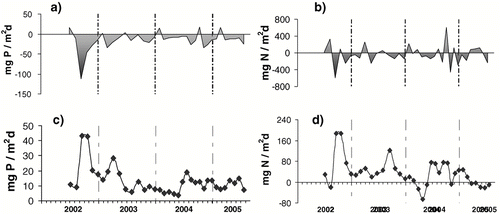
Despite favorable redox conditions during stratification, P release from the sediment was not a major source to VB, contrary to expectations based on Nürnberg (Citation1984, Citation1998) and CitationJensen et al. (1992). The times when P release from the sediments dominated over sedimentation at VB coincided more with low net P input () than anoxic conditions. Hypolimnetic TP concentrations in VB (mean 100 μ g/L, 3.23 μ M from ,) are not higher than those used (1–543 μ g/L in stratified lakes, 16–761 μg/L in polymictic) in the P release prediction models (CitationNürnberg 1998). Therefore, it seems that our observations in VB support the findings of CitationGächter and Wehrli (1998) and CitationPrairie et al. (2002), that P release depends more on P sedimentation and the sediments retention capacity than on hypolimnetic oxygen concentration.
Variation of NIP(N) over time exhibited alternating positive and negative peaks (), tracking the variability of the internal process dominating N exchange with the sediments and the atmosphere. However, once N sedimentation is taken into account, the estimated net N2 fixation () showed that fixation exceeded denitrification most of the time in VB. High N2 fixation rates in VB can be sustained by the dominance of cyanobacteria (CitationNandini et al. 2008) and nitrogen limitation (CitationMerino-Ibarra et al. 2008). During 2002–2005, the DIN:TDP ratio (molar) in the epilimnetic layer of the reservoir indicated the persistence of N limitation in VB except during full circulation (). This is consistent with the pattern found, where minimal or negative net N2 fixation values occurred mainly during mixing.
Figure 7 Temporal variation in VB of (a) net N2 fixation, (b) epilimnetic nitrate concentration and (c) epilimnetic DIN:TDP ratio (molar).

On the average (161.4 mg N/m2d, from ), our estimates indicate a very high net N2 fixation for VB that almost doubled the N load estimated for VB during 2002–2005 (). This result should be verified by acetylene reduction studies. Both the low N:P and the high P load would favor a high N2 fixation in VB; nevertheless, our estimates of N2 fixation in VB are well above the range reported by CitationHowarth et al. (1988) for eutrophic lakes. We may be overestimating N2 fixation by either underestimating the N load or overestimating net N sedimentation. The latter could be true if (1) an important fraction of P sedimentation is in inorganic form and/or (2) nitrogen mineralizes more than P in VB. Given an apparent paucity of studies of N2 fixation in reservoirs versus lakes, more measurements of N2 fixation in eutrophic reservoirs are needed for their effective management.
Comparison with other tropical lakes and reservoirs
CitationSalas and Martino (1991) developed a phosphorus trophic model for warm-water tropical lakes that classified lakes using numeric boundaries different from temperate lakes. When classified with this model, in terms of its TP content, VB has a 70% probability of being eutrophic. The high P sedimentation rate we found in VB is also consistent with this model, which predicts P sedimentation rates in tropical lakes that are 2-fold those of temperate lakes with similar detention times. Comparison of VB with the 27 warm-water tropical lakes of America classified by Salas and Martino (Citation1991; ) shows that VB is within the range of conditions found in eutrophic systems. Its behavior is most similar to other deep lakes and reservoirs that have above geometric average detention times (0.283 y) in this set.
Figure 8 Comparison of VB with other warm-water tropical lakes in the Load TP/Z vs Detention time plot and trophic categories (after CitationSalas and Martino 1991).
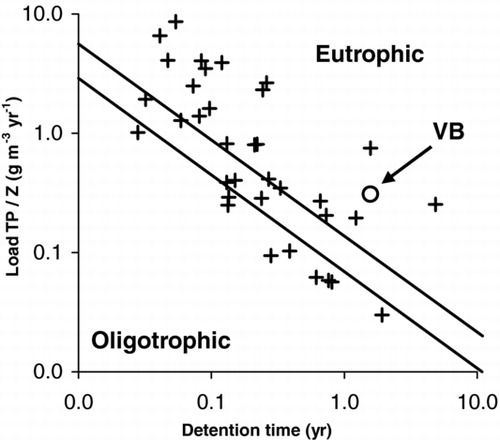
Summary and recommendations
Four years of observations confirmed that VB behaves as a warm monomictic water body and that its mean hypolimnetic temperature increases throughout the stratification period. Water storage in VB remained near its maximum capacity during 2002–2005, but diminished drastically in the following years. River and sewage inputs to VB must be gauged to prevent water shortage and to understand changes in water quality. These are basic management practices, applied in other reservoirs, which are crucial to protect water supply for MCMA.
Nutrient loading in VB exhibited time and source variation, likely due to uncontrolled domestic and agricultural inputs. The load from the Amanalco River has increased 276% for P and 203% for N since 1992–1993. Sewage from the town of Valle de Bravo also has increased its P load by 258% since 1987. Most (85%) of the P input to the reservoir was incorporated into the sediments, based on mass balance. Phosphorus release from the sediment was not a major source in VB. Our calculated net N2 fixation for VB doubles the N loading from rivers and sewage. Low P release rates and high N2 fixation potential suggest biological imbalance in VB, which can be brought into balance by reducing external P load. The control of N load is not likely to reduce N concentrations in VB because of the high N2 fixation rates. Further, the dual-nutrient reduction strategy necessary to protect coastal ecosystems (CitationConley et al. 2009) is not needed in VB because its water is totally used for MCMA supply and does not drain to the coast. We therefore recommend a P load reduction strategy to manage water quality in VB and to control cyanobacteria blooms.
The management actions needed to implement this strategy include (a) treating sewage from VB town to reduce P content substantially and (b) monitoring and regulating the use of fertilizers, as well as input from livestock, fish farms and town sewages, to reduce P load from the Amanalco watershed. Similar actions have resulted in substantial improvements in water quality in North American and European reservoirs and lakes (CitationConley et al. 2009, CitationJeppesen et al. 2005).
Because VB shares the behavior of other eutrophic tropical lakes and reservoirs modeled by CitationSalas and Martino (1991), the recommendations here outlined for VB can be useful for the management of other deep tropical reservoirs.
Our estimates suggest that eutrophic reservoirs could exhibit much higher N2 fixation rates than those so far reported for eutrophic lakes. This could be overestimation, however, which highlights the need for direct N2 fixation determinations in eutrophic reservoirs.
Acknowledgments
We thank Luz Maria López, Lourdes N. Murueta, Flor Arcega, Irina Cruz, Sofía Montalvo, Rebeca Sánchez, Claudia N. Saavedra, Patricia Memije, Alfredo Gallardo, Felipe Solís and Karina Castro for their help with field and lab work. This paper was substantially improved with the pertinent comments and suggestions of three anonymous reviewers and the editor of LRM. English grammar and syntax were also revised by Marcos Merino. The paper was accomplished with financial support from research projects IN-207702 funded by UNAM-PAPIIT and SEMARNAT-CONACYT C01-1125 to M. Merino-Ibarra.
Notes
*Calculated using total atmospheric deposition rates from CitationCampo et al. 2001 (0.16 kg TP/ha· yr) and CitationFenn et al. 1999 (5.5 kg TN/ha· yr).
REFERENCES
- Bachmann , R W . 1984 . Calculation of phosphorus and nitrogen loadings to natural and artificial lakes . Vehr Internat Verein Limnol , 22 : 239 – 243 .
- Bradford , M E and Peters , R H . 1987 . The relationship between chemically analyzed phosphorus fractions and bioavailable phosphorus . Limnol Oceanog , 32 ( 5 ) : 1124 – 1137 .
- Campo , J , Maass , M , Jaramillo , V J , Martínez-Yrizar , A and Sarukhan , J. 2001 . Phosphorus cycling in a Mexican tropical dry forest ecosystem . Biogeochemistry , 53 : 161 – 179 .
- Conley , D J , Paerl , H W , Howarth , R W , Boesch , D F , Seitzinger , S P , Havens , K E , Lancelot , C and Likens , G E . 2009 . Controlling eutrophication: Nitrogen and phosphorus . Science , 323 : 1014 – 1015 .
- [CNA] Comisión Nacional del Agua . 2008 . Estadísticas del Agua en México [Water statistics in Mexico] México , DF
- Downing , J A , McClain , M , Twilley , R , Melack , J M , Elser , J , Rabalais , N N , Lewis , W M Jr , Turner , R E , Corredor , J Soto , D. 1999 . The impact of accelerating land-use change on the N-cycle of tropical aquatic ecosystems: current conditions and projected changes . Biogeochemistry , 46 : 109 – 148 .
- Fenn , M E , de Bauer , L I , Quevedo-Nolasco , A and Rodriguez-Frausto , C. 1999 . Nitrogen and sulfur deposition and forest nutrient status in the valley of Mexico . Water Air Soil Pollut , 113 : 155 – 174 .
- Gächter , R. and Wehrli , B. 1998 . Ten years of artificial mixing and oxygenation: no effect on the internal phosphorus loading of two eutrophic lakes . Environ Sci Technol , 32 : 3659 – 3665 .
- Grasshoff , K. , Kremling , K. and Ehrhardt , M. 1983 . Methods of seawater analysis , Weinheim : Verlag Chemie .
- Hart , B T , van Dok , W. and Djuangsih , N. 2002 . Nutrient budget for Saguling Reservoir, West Java, Indonesia . Water Res. , 36 : 2152 – 2160 .
- Howarth , R W , Marino , R. , Lane , J. and Cole , J J . 1988 . Nitrogen fixation in freshwater, estuarine marine ecosystems. 1. Rates and importance . Limnol Oceanog. , 33 ( 4 ) : 669 – 687 . part 2
- [INEGI] Instituto Nacional de Estadística, Geografía e Informática . 1996 . Anuario Estadístico del Estado de México. [Annual statistics of the State of Mexico] México , , Spanish
- Jensen , H S , Kristensen , P. , Jeppesen , E. and Skythe , A. 1992 . Iron: phosphorus ratio in surface sediment as an indicator of phosphate release from aerobic sediments in shallow lakes . Hydrobiologia , 235/236 : 731 – 743 .
- Jeppesen , E. , Søndergaard , M. , Jensen , J P , Havens , K E , Anneville , O. , Carvalho , L. , Coveney , M F , Deneke , R. Dokulil , M T . 2005 . Lake responses to reduced nutrient loading – an analysis of contemporary long-term data from 35 case studies . Freshwater Biol. , 50 : 1747 – 1771 .
- Kirkwood , DS . 1994 . SanPlus segmented flow analyzer and its applications. Seawater analysis , Amsterdam : Skalar .
- Lewis , W M Jr. 2000 . Basis for the protection and management of tropical lakes . Lake Reserv Manag , 5 : 35 – 48 .
- Lewis , W M Jr. 2002 . Causes for the high frequency of nitrogen limitation in tropical lakes . Vehr Internat Verein Limnol. , 28 : 210 – 213 .
- Martin , J L and McCutcheon , S C . 1999 . Hydrodynamics and transport for water quality modeling , CRC Press Inc. .
- Merino-Ibarra , M. , Monroy-Ríos , E. , Vilaclara , G. , Castillo , F S , Gallegos , M E and Ramírez-Zierold , J. 2008 . Physical and chemical limnology of a wind-swept tropical highland reservoir . Aquat Ecol. , 42 : 335 – 345 .
- Nandini , S. , Merino-Ibarra , M. and Sarma , S SS . 2008 . Seasonal changes in the zooplankton abundances of the reservoir Valle de Bravo (State of Mexico, Mexico) . Lake Reserv Manag , 24 : 321 – 330 .
- Nürnberg , GK . 1984 . The prediction of internal phosphorus load in lakes with anoxic hypolimnia . Limnol Oceanog , 29 : 111 – 124 .
- Nürnberg , GK . 1998 . Prediction of annual and seasonal phosphorus concentrations in stratified and and polymictic lakes . Limnol Oceanog , 43 ( 7 ) : 1544 – 1552 .
- Olvera-Viascán , V. , Bravo-Inclán , L. and Sánchez-Chávez , J. 1998 . Aquatic ecology management assessment in Valle de Bravo reservoir and its watershed . Aquat Ecosyst Health Manag. , 1 : 277 – 290 .
- Olvera , VV . 1990 . Estudio de la eutroficación del embalse Valle de Bravo, México. [Study of eutrophication in the Valle de Bravo reservoir, Mexico] , MS thesis Mexico City , , Spanish : Facultad de Ciencias, Universidad Nacional Autónoma de México .
- Prairie , Y T , De Montigny , C. and del Giorgio , P A . 2002 . Anaerobic phosphorus release from sediments: a paradigm revisited . Verh Internat Verein Limnol , 27 : 4013 – 4020 .
- Pujo-Pay , M. and Raimbault , P. 1994 . Improvement of the wet-oxidation procedure for simultaneous determination of particulate organic nitrogen and phosphorus collected on filters . Mar Ecol Prog Ser. , 105 : 203 – 207 .
- Ryding , S O and Rast , W. 1989 . The control of eutrophication of lakes and reservoirs , vol. 1 , Paris : Parthenon Press, UNESCO . Man and the Biosphere Series (MAB)
- Salas , H J and Martino , P. 1991 . A simplified phosphorus trophic state model for warm-water tropical lakes . Water Res. , 25 ( 3 ) : 341 – 350 .
- Smith , S V , Serruya , S. , Geifman , Y. and Berman , T. 1989 . Internal sources and sinks of water, P, N, Ca and Cl in Lake Kinneret . Israel. Limnol Oceanog. , 34 ( 7 ) : 1202 – 1213 .
- Tortajada , C. 2006 . Water management in Mexico City Metropolitan Area . Water Resources Development , 22 ( 2 ) : 353 – 376 .
- Valderrama , JC . 1981 . The simultaneous analysis of total nitrogen and total phosphorus in natural waters . Mar Chem. , 10 : 109 – 122 .